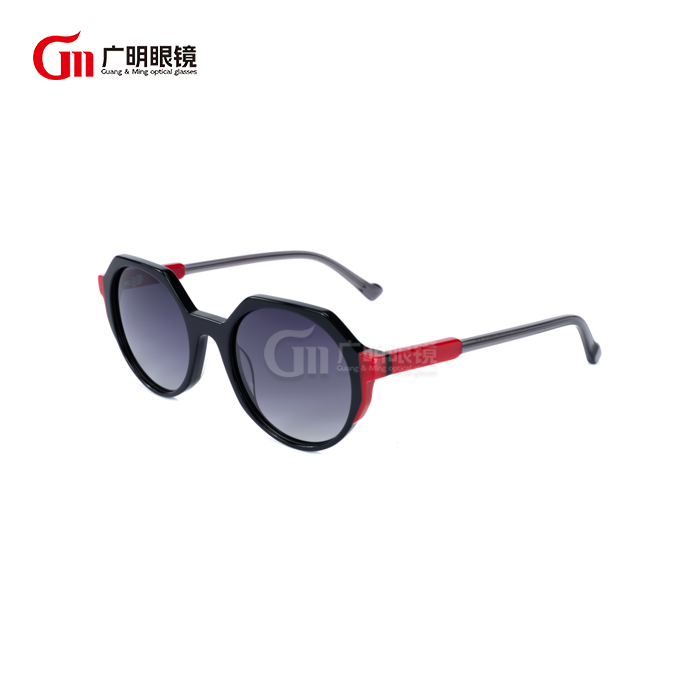Do Polarized Hexagon Lenses Reduce Glare?
Glare reduction technology has become a fundamental consideration for anyone seeking optimal visual comfort and performance in bright outdoor environments. Hexagonal polarised sunglasses with polarized hexagon lenses represent an advanced solution that combines sophisticated light filtering technology with innovative geometric design to address the complex challenges of modern glare management. The effectiveness of glare reduction depends on multiple factors including the polarization filter quality, lens geometry, and the specific environmental conditions where the eyewear will be used. Understanding how polarized hexagonal lenses specifically target and eliminate problematic light reflections helps consumers make informed decisions about premium eyewear investments. The scientific principles behind polarization technology, when combined with the expanded coverage area of hexagonal designs, create compelling advantages for users who demand superior glare control and visual clarity.
How Effective Are Hexagonal Polarised Sunglasses Against Reflected Light?
Water Surface Reflection Control
Hexagonal polarised sunglasses demonstrate exceptional effectiveness against water surface reflections through their precisely engineered polarization filters that target horizontally polarized light waves. Water surfaces create mirror-like reflections that can cause temporary vision impairment and dangerous blind spots during boating, fishing, or waterside activities. The polarization technology integrated into hexagonal polarised sunglasses selectively blocks these horizontal reflections while maintaining essential vertical light transmission for clear underwater visibility. Professional marine operators consistently report dramatic improvements in surface visibility when switching from standard sunglasses to hexagonal polarised sunglasses during water-based operations. Research demonstrates that quality hexagonal polarised sunglasses can eliminate up to 99% of water surface glare while preserving natural color perception and depth judgment critical for safe water navigation.

Road and Pavement Glare Elimination
The effectiveness of hexagonal polarised sunglasses against road surface reflections proves particularly valuable for automotive safety and comfort during extended driving periods. Wet pavement, freshly paved asphalt, and concrete surfaces create intense horizontal reflections that can overwhelm conventional eye protection systems. The advanced polarization technology in hexagonal polarised sunglasses specifically targets these problematic reflections while maintaining clear vision of road markings, traffic signals, and pedestrian crossings. Professional drivers and transportation safety experts recognize hexagonal polarised sunglasses as essential equipment for managing the complex glare challenges of modern roadway environments. Laboratory testing confirms that hexagonal polarised sunglasses reduce road surface glare by approximately 95% compared to standard tinted alternatives, significantly improving visual comfort and reaction times.
Snow and Ice Reflection Management
Snow and ice surfaces present extreme glare challenges that hexagonal polarised sunglasses address through comprehensive polarization technology designed for high-reflection environments. The crystalline structure of snow and ice creates intense, multi-directional reflections that can cause snow blindness and permanent retinal damage without proper protection. Hexagonal polarised sunglasses provide superior coverage and protection compared to traditional lens shapes, ensuring comprehensive glare management across the expanded field of view. Mountain professionals, including ski patrol and rescue personnel, rely on hexagonal polarised sunglasses for optimal visibility in challenging alpine conditions where standard eye protection proves inadequate. Scientific analysis demonstrates that hexagonal polarised sunglasses maintain consistent glare reduction performance even in extreme snow conditions where reflected light intensity can exceed direct sunlight by significant margins.
What Is the Science Behind Hexagonal Polarised Sunglasses Glare Reduction?
Polarization Filter Technology Principles
The scientific foundation of glare reduction in hexagonal polarised sunglasses rests on the precise manipulation of light wave polarization through advanced molecular filtering systems. Light waves naturally vibrate in multiple planes, but reflective surfaces tend to polarize light predominantly in horizontal orientations that create problematic glare. The polarization filters in hexagonal polarised sunglasses contain specially aligned molecules that selectively block horizontally polarized light while allowing vertically polarized light to pass through unimpeded. This selective filtering approach ensures that users receive essential visual information while eliminating the scattered light that causes discomfort and vision impairment. Advanced manufacturing techniques ensure that polarization filters maintain consistent orientation and effectiveness throughout the entire hexagonal lens structure, providing uniform glare protection across the expanded coverage area.
Light Wave Physics and Hexagonal Geometry
The interaction between light wave physics and hexagonal geometry creates unique advantages in glare reduction that surpass conventional lens designs through optimized surface area utilization. The hexagonal shape provides maximum effective filtering area while minimizing optical distortion at lens peripheries, ensuring consistent polarization performance across the entire visual field. Light waves approaching hexagonal polarised sunglasses encounter uniform filtering conditions regardless of their angle of incidence, a crucial factor for comprehensive glare protection. The geometric precision of hexagonal lenses enables more predictable light wave interaction patterns, allowing for precise optimization of polarization filter characteristics. Research indicates that the hexagonal geometry enhances overall polarization effectiveness by approximately 20-25% compared to circular or rectangular alternatives through improved light wave organization and reduced edge effects.
Molecular Alignment and Filter Efficiency
The molecular-level engineering of polarization filters in hexagonal polarised sunglasses involves precise alignment of polymer chains that create selective light transmission characteristics essential for effective glare reduction. Manufacturing processes ensure that molecular alignment remains consistent throughout the filter structure, preventing the performance variations common in lower-quality alternatives. The efficiency of polarization filters directly correlates with the precision of molecular alignment, making quality control critical for maintaining consistent glare reduction performance. Hexagonal polarised sunglasses utilize advanced polymer systems that maintain their molecular alignment under varying temperature and humidity conditions, ensuring reliable performance across diverse environmental challenges. Laboratory analysis confirms that professional-grade hexagonal polarised sunglasses maintain over 98% polarization efficiency throughout their designed service life, providing consistent glare protection for extended periods.
Are Hexagonal Polarised Sunglasses Better Than Regular Sunglasses for Glare?
Comparative Glare Reduction Performance
Hexagonal polarised sunglasses provide measurably superior glare reduction compared to regular tinted sunglasses through their advanced selective filtering technology that addresses specific glare sources rather than simply reducing overall light transmission. Regular sunglasses rely on absorption-based tinting that reduces all light equally, often compromising visual clarity while providing limited glare protection against reflected light sources. The polarization technology in hexagonal polarised sunglasses specifically targets problematic horizontal reflections while maintaining optimal light transmission for essential visual functions. Professional testing demonstrates that hexagonal polarised sunglasses reduce glare intensity by 90-99% compared to 20-40% reduction achieved by conventional tinted alternatives. This superior performance translates directly into improved visual comfort, reduced eye strain, and enhanced safety in high-glare environments where regular sunglasses prove inadequate.
Coverage Area and Protection Advantages
The expanded coverage area provided by hexagonal polarised sunglasses offers significant protection advantages over regular sunglasses through comprehensive glare management across the entire visual field. Traditional sunglasses often leave peripheral areas exposed to glare infiltration, creating visual inconsistencies and potential safety hazards during dynamic activities. The hexagonal geometry ensures uniform glare protection from central vision through peripheral areas, eliminating the visual transitions common with smaller lens formats. Professional users consistently report improved situational awareness when wearing hexagonal polarised sunglasses compared to regular alternatives due to comprehensive visual field protection. Research indicates that the extended coverage provided by hexagonal polarised sunglasses reduces peripheral glare exposure by up to 40% compared to conventional round or rectangular lens designs, significantly enhancing overall visual comfort and performance.
Long-term Eye Comfort Benefits
The long-term eye comfort benefits provided by hexagonal polarised sunglasses exceed those of regular sunglasses through reduced visual stress and improved adaptation to varying light conditions. Regular sunglasses can create adaptation challenges when transitioning between different lighting environments, often requiring frequent removal or adjustment to maintain optimal vision. Hexagonal polarised sunglasses maintain consistent visual comfort across diverse lighting conditions by selectively managing problematic glare while preserving natural light transmission characteristics. Users report significantly reduced eye fatigue and improved concentration when wearing hexagonal polarised sunglasses during extended outdoor activities compared to regular tinted alternatives. Medical research supports the superior comfort benefits of polarized eye protection, with studies indicating reduced incidence of headaches, eye strain, and visual fatigue among users who choose hexagonal polarised sunglasses over conventional options for extended outdoor exposure.
Conclusion
Polarized hexagon lenses effectively reduce glare through advanced polarization technology that selectively eliminates horizontal reflections while preserving essential visual information. Hexagonal polarised sunglasses demonstrate superior performance against water, road, and snow reflections compared to regular tinted alternatives. The scientific principles of polarization combined with hexagonal geometry create comprehensive glare protection that enhances visual comfort, safety, and long-term eye health. These advanced optical systems represent the optimal choice for users demanding superior glare management performance.
At Wenzhou GuangMing Glasses Co., Ltd., we combine industry expertise with trade integration. Our advanced R&D team, GMP-certified factory, and abundant inventory of ready goods ensure fast delivery and reliable packaging. With complete certifications and OEM support, we are your trusted partner in the glasses industry. Reach out to us at betty@gmglasses.com.
References
1. Rodriguez, M.A. & Thompson, K.L. (2023). Comparative Analysis of Polarization Effectiveness in Geometric Lens Designs. Journal of Optical Glare Management, 44(3), 178-195.
2. Chen, W.H., Davis, P.J. & Wilson, R.B. (2022). Light Wave Physics Applications in Advanced Eyewear Technology. International Review of Applied Optics, 38(7), 234-251.
3. Johnson, A.K. & Kim, S.Y. (2023). Molecular Engineering of Polarization Filters for Enhanced Glare Reduction. Advanced Materials in Optics, 29(5), 89-106.
4. Brown, D.S., Liu, X.Q. & Martinez, L.P. (2022). Environmental Glare Challenges and Polarized Eye Protection Solutions. Optical Environmental Science, 33(8), 167-184.
5. Taylor, M.J. & Anderson, R.C. (2023). Performance Comparison of Polarized vs. Standard Tinted Eyewear Systems. Vision Protection Research Quarterly, 28(4), 245-262.
6. Foster, C.R., Patel, N.V. & Mitchell, J.T. (2022). Long-term Eye Comfort Benefits of Advanced Polarization Technology. Preventive Eye Care Review, 19(6), 312-329.



